Attractions Nearby Limassol, Day Trips and Excursions
(Limassol, Cyprus)
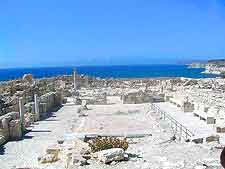
If you are holidaying in Limassol and have rented your own set of wheels, then a myriad of day trips and outlying attractions present themselves. Just a short drive from Limassol are the archaeological attractions of Ancient Amathos, Ancient Kourion, the Sanctuary of Apollon Ylatis and Kolossi Castle.
Those looking for nightlife and some different beach attractions should take an excursion from Limassol, heading for either
Larnaca or
Paphos. Alternatively, the nearby Cypriot village of Episkopi is often of interest to the history buffs, since it is home to the acclaimed Kourion Museum.
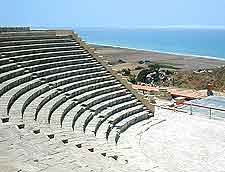
Ancient Kourion
Ancient Kourion enjoys a stunning hillside setting, where it overlooks the Mediterranean Sea and offers archaeological attractions galore. Often extremely popular with sightseers and day trippers from Limassol, Ancient Kourion is best visited early in the morning or alternatively late in the afternoon, so that you can avoid the predictable crowds and heat of the day. The main sights of Ancient Kourion include an early basilica, an exceptional reconstructed amphitheatre, the 5th-century Annexe of Eustolios, and the House of the Gladiators. If you want to make a day of it, then consider combining your visit with an excursion to the two neighbouring sites of Kolossi Castle and the Sanctuary of Apollon Ylatis.
Open hours: daily, July and August - 08:00 to 19:30, September to June - 07:30 to 17:00
Admission: charge
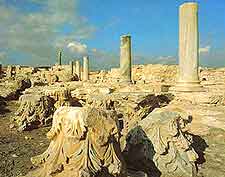
Ancient Amathos
Ancient Amathos is a major archaeological site situated some 11 km / 7 miles to the east of Limassol and was historically one of the four kingdoms of
Cyprus, with the others being Paphos (Pafos), Salamis and Soloi. Steeped in Greek legend and founded in 1000 BC, the importance of Ancient Amathos began to decline in the 12th century, when its harbour started to silt up and soon after it was destroyed by King Richard. Although much of this site has suffered at the hands of looters, there is still much to see in the way of attractions, particularly if you carefully follow the schematic map. Excavations here began as recently as the 1980s and have uncovered an early Christian basilica and some impressive remains of an acropolis and sanctuary to Aphrodite.
Open hours: daily, July and August - 09:00 to 19:30, September to June - 09:00 to 17:00
Admission: charge
Akrotiri Peninsula
There are a few attractions of note spread around the Akrotiri Peninsula, although a sizeable chink of this area is taken up by the Akrotiri Sovereign Base Area. Owned by Britain following negotiated terms in 1960, when Cyprus received its independence, the Akrotiri Sovereign Base Area comprises a large military base, as well as the village of Akrotiri, where locals are in the unusual position of having dual-citizenship. Also on the peninsula is the Holy Monastery of St. Nicholas and the Cats, which was founded in the year 327 AD and named after its large group of resident cats, imported from Palestine and Egypt to keep the numerous surrounding snakes at bay.
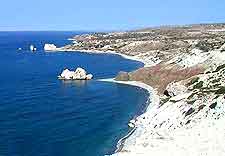
Episkopi
The charming village of Episkopi is situated just 14 km / 9 miles to the west of Limassol and is home to a handful of notable attractions, the most visited of which is the Kourion Museum. The ever-popular Kourion Museum is filled with terracotta relics and treasures unearthed at the nearby site of Ancient Kourion, and is housed within the former residence of acclaimed archaeologist George McFadden. If you are planning to stay for a bite to eat, then the 'kleftiko' (slowly cooked lamb) at the Old Stables comes very highly recommended by the owner of Antony's Garden House Hotel.
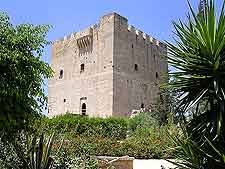
Kolossi Castle
Kolossi Castle is a prominent stronghold just a short drive from Limassol and stands alongside a number of large, spreading vineyards. More of a fortified house than an actual fortress, Kolossi Castle is believed to date from the early 13th century, although its present incarnation was completed in the middle of the 15th century. Entrance to Kolossi Castle is gained via a drawbridge, with a spiral staircase leading visitors to the rooftop battlements. On the eastern side of the castle, an outbuilding named the 'sugar factory' offers an insight into the historical processing of sugar cane on Cyprus.
Open hours: daily, July and August - 09:00 to 19:30, September to June - 09:00 to 17:00
Admission: free
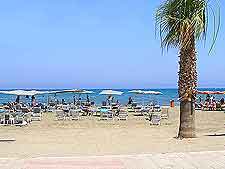
Larnaca
Larnaca is to be found to the north-east of Limassol, where it has long been a popular resort with a seductive charisma. The main promenade of Larnaca looks particularly tropical in character, being lined with mature palm trees and lively cafes, while the historical Old Turkish quarter contains more traditional buildings and
attractions. Larnaca is a fairly compact city with some renowned
museums, such as both the Medieval Museum at the
Larnaca Fort and the Pierides Archaeological Foundation Museum. The surrounding
beaches are pleasant enough and another reason to enjoy a day trip to Larnaca, with the McKenzie Beach being amongst the best options and conveniently located just off the Finikoudes / Phinikoudes promenade.
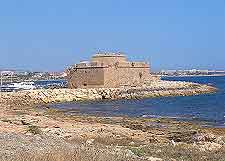
Paphos
A top seaside resort of the far south-westerly corner of Cyprus, Paphos (Pafos) lies directly to the west of Limassol. The attractions of Paphos are in plentiful supply and include stunning sandy
beaches, traditional
restaurants serving Cypriot cuisine, lively
nightclubs and an excellent array of
shops, along the busy street of Leoforos Arhiepiskopou Makariou III. There are two very distinct parts of Paphos, Ktima and Kato Pafos, and both of these sections are connected by regular buses, since they are around 3 km / 2 miles apart. Paphos sights not to miss include the
Tombs of the Kings, the Pafos Archaeological Site, the ancient Agora (Forum) and Asklipieion remains, and of course the Municipal Beach.
Sanctuary of Apollon Ylatis
At a mere 2 km / 1.5 miles from the entrance to Ancient Kourion and relatively close to Limassol, the Sanctuary of Apollon Ylatis is clearly signposted from the main highway. This whole area was established during the 8th century, honouring the Greek god Apollo (God of the Woods). The remains and attractions around the Sanctuary of Apollon Ylatis are mainly Roman in origin and were destroyed by a serious earthquake in the 4th century AD. The sanctuary has been partially restored, while the sports arena (palaestra), priests' quarters and huge stadium are still clearly visible.
Open hours: daily, May to September - 09:00 to 19:30, October to April - 09:00 to 17:30
Admission: charge
 If you are holidaying in Limassol and have rented your own set of wheels, then a myriad of day trips and outlying attractions present themselves. Just a short drive from Limassol are the archaeological attractions of Ancient Amathos, Ancient Kourion, the Sanctuary of Apollon Ylatis and Kolossi Castle.
If you are holidaying in Limassol and have rented your own set of wheels, then a myriad of day trips and outlying attractions present themselves. Just a short drive from Limassol are the archaeological attractions of Ancient Amathos, Ancient Kourion, the Sanctuary of Apollon Ylatis and Kolossi Castle.




